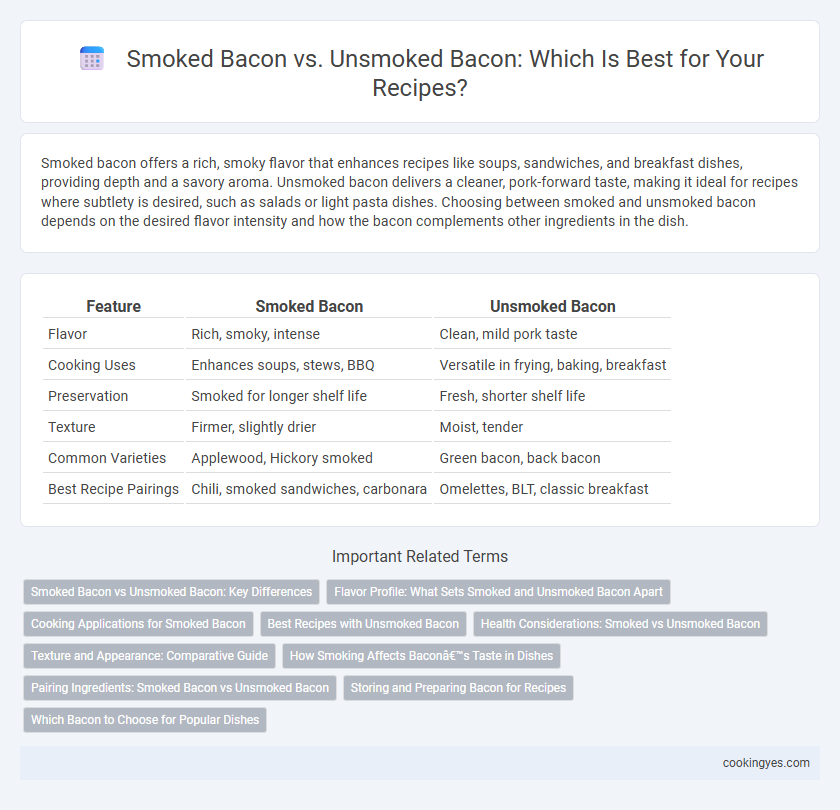Smoked bacon offers a rich, smoky flavor that enhances recipes like soups, sandwiches, and breakfast dishes, providing depth and a savory aroma. Unsmoked bacon delivers a cleaner, pork-forward taste, making it ideal for recipes where subtlety is desired, such as salads or light pasta dishes. Choosing between smoked and unsmoked bacon depends on the desired flavor intensity and how the bacon complements other ingredients in the dish.
Table of Comparison
| Feature | Smoked Bacon | Unsmoked Bacon |
|---|---|---|
| Flavor | Rich, smoky, intense | Clean, mild pork taste |
| Cooking Uses | Enhances soups, stews, BBQ | Versatile in frying, baking, breakfast |
| Preservation | Smoked for longer shelf life | Fresh, shorter shelf life |
| Texture | Firmer, slightly drier | Moist, tender |
| Common Varieties | Applewood, Hickory smoked | Green bacon, back bacon |
| Best Recipe Pairings | Chili, smoked sandwiches, carbonara | Omelettes, BLT, classic breakfast |
Smoked Bacon vs Unsmoked Bacon: Key Differences
Smoked bacon has been cured with smoke, imparting a rich, smoky flavor and aroma that enhances savory dishes, while un-smoked bacon offers a more natural, milder pork taste ideal for recipes where bacon's flavor should not overpower. Smoked bacon typically has a darker color and firmer texture due to the smoking process, whereas un-smoked bacon maintains a lighter pink hue and softer consistency, influencing the cooking method and final dish texture. Recipes using smoked bacon benefit from its depth and complexity, making it perfect for hearty meals, while un-smoked bacon suits dishes requiring subtlety and flexibility in seasoning.
Flavor Profile: What Sets Smoked and Unsmoked Bacon Apart
Smoked bacon offers a rich, deep flavor profile infused with smoky, woody notes that enhance savory dishes, while unsmoked bacon delivers a purer, salt-cured pork taste that highlights the meat's natural sweetness. The smoking process introduces complex aromatics like hickory or applewood, adding intensity and a slightly charred finish, which makes smoked bacon ideal for recipes requiring robust flavors. In contrast, unsmoked bacon provides a cleaner, milder flavor, perfect for recipes where subtlety and the true essence of pork need to shine without overwhelming other ingredients.
Cooking Applications for Smoked Bacon
Smoked bacon enhances recipes with its rich, smoky flavor, making it ideal for adding depth to soups, stews, and casseroles. Its pronounced taste pairs well with hearty vegetables and complements savory dishes like carbonara or quiche. When cooked, smoked bacon renders flavorful fat that can be used for frying eggs, sauteing greens, or infusing sauces.
Best Recipes with Unsmoked Bacon
Unsmoked bacon, also known as green bacon, offers a milder, salt-cured flavor that enhances dishes without overpowering other ingredients, making it ideal for delicate recipes such as quiches, carbonara, and potato salads. Its subtle taste allows for better integration with fresh herbs, vegetables, and cheeses, providing a balanced, savory profile perfect for gourmet cooking. Using unsmoked bacon in recipes preserves the natural pork flavor, delivering versatility and authenticity in culinary applications that demand nuanced seasoning.
Health Considerations: Smoked vs Unsmoked Bacon
Smoked bacon contains compounds such as polycyclic aromatic hydrocarbons (PAHs) and nitrosamines formed during the smoking process, which may increase health risks when consumed in large amounts. Unsmoked bacon typically has fewer of these harmful compounds but still contains nitrates and high levels of sodium, which require moderation for a balanced diet. Both types should be consumed in limited quantities due to their processed meat nature and associated potential links to cardiovascular disease and certain cancers.
Texture and Appearance: Comparative Guide
Smoked bacon features a darker, reddish-brown hue with a slightly firmer, crispier texture ideal for adding a robust flavor and crunch to recipes. Unsmoked bacon maintains a lighter pink color and softer, more pliable texture, making it suitable for dishes where a mild, subtle bacon taste is preferred without overpowering other ingredients. The choice between smoked and unsmoked bacon affects both the visual appeal and mouthfeel, influencing the overall sensory experience of dishes like salads, sandwiches, and breakfast plates.
How Smoking Affects Bacon’s Taste in Dishes
Smoking bacon imparts a rich, robust flavor profile characterized by deep smoky, woody, and slightly sweet notes that enhance savory dishes. The smoking process also adds complexity and a subtle charred aroma, which intensifies when cooked, making smoked bacon a preferred choice for recipes requiring bold taste. In contrast, unsmoked bacon offers a milder, saltier taste that allows other ingredients to shine, ideal for dishes where a lighter bacon flavor is desired.
Pairing Ingredients: Smoked Bacon vs Unsmoked Bacon
Smoked bacon offers a rich, smoky flavor ideal for pairing with bold ingredients like sharp cheddar, caramelized onions, and dark leafy greens such as kale or Swiss chard. Unsmoked bacon has a milder, pork-forward taste that complements delicate flavors like fresh herbs, avocado, tomatoes, and mild cheeses like mozzarella or ricotta. Choosing between smoked and unsmoked bacon depends on the desired intensity and harmony of flavors within your recipe.
Storing and Preparing Bacon for Recipes
Smoked bacon offers a richer flavor profile that enhances recipes but requires careful storage in an airtight container or vacuum-sealed bag to preserve its smoky taste and prevent spoilage. Unsmoked bacon, or green bacon, has a milder flavor and shorter shelf life, necessitating refrigeration and faster use to maintain freshness. When preparing, smoked bacon is ideal for recipes requiring bold, smoky notes, while unsmoked bacon is preferable for dishes that benefit from natural pork flavors without added smoke.
Which Bacon to Choose for Popular Dishes
Smoked bacon adds a rich, smoky flavor ideal for dishes like carbonara, BLTs, and baked beans, enhancing depth and warmth. Unsmoked bacon, often called green or fresh bacon, works best in recipes requiring a milder taste and crisp texture, such as quiches, salads, or breakfast scrambles. Choosing smoked or unsmoked bacon depends on whether the recipe benefits from intense smokiness or a subtler pork flavor.
Smoked Bacon vs Unsmoked Bacon for Recipes Infographic

 cookingyes.com
cookingyes.com